Scotland’s hidden treasures
Thomas Baldwin asks a number of contributors for their suggestions on places of pilgrimage and Scotland’s ‘hidden treasures’ for the summer of 2021.
WITH most of us seeming set for a ‘staycation’ this summer, we invited people with an interest in pilgrimage to tell us some of their favourite lesser-known churches and places of pilgrimage to visit in Scotland. Some have chosen to write about a region, others more specific attractions. We hope it gives you some ideas (but please visit responsibly!), and please write and tell us where we’ve missed.
Lord Wallace, Moderator of the General Assembly of the Church of Scotland in 2021/22
Orkney
Back in March, taking advantage of Orkney’s lower level Covid-19 status, Rosie and I spent a most enjoyable staycation week in a self-catering cottage on Westray in the North Isles of Orkney. I had visited the island on many occasions as an MP and MSP, but meetings, surgeries or other ‘official business’ had always precluded proper discovery of the island’s historic and scenic sites. This was a time to put that right; and combined with a sense of calm to encourage reading and bracing walks to clear the head, we returned home refreshed and with batteries recharged.
I had, on numerous previous occasions, taken the world’s shortest scheduled flight from Westray to Papa Westray.
Almost 30 years ago, with my family and others, I walked a trail round part of Papay taking in the remains of the ancient medieval chapel and pilgrimage destination at St Tredwell’s Loch and the Knap of Howar, (older than the Pyramids), before arriving for a service of rededication at the restored St Boniface Kirk, a site where worship has been conducted for almost 1300 years. It is a special place.
Each of Orkney’s islands has its own distinctive character. But a word of caution. Even in March, we were told that accommodation for this summer was being quickly booked up. But if this year is too late, remember that these places have been around for centuries, and, in some cases, millennia. They are not going anywhere and are worth a wait.
Dan Romani, Faith in Cowal project worker
The Cowal Peninsula
The Cowal Peninsula is just west of Scotland’s largest city. It’s roughly the same travel time from Glasgow as it is to Loch Lomond, and Cowal is just as beautiful a destination, if not more so. Cowal makes for a great ‘staycation‘ destination because it feels a million miles away from the busyness of the city centre or the throngs of tourists around Loch Lomond.
There’s plenty to do here too. If you’re staying near Dunoon you could take a pottery workshop, take a boat trip or a dive to find wreckages, learn about the history of the area at Castle House Museum and Historic Kilmun, or enjoy a great meal at one of the nearby rural eateries. There’s also the twin delights of Benmore Botanic Gardens and Puck’s Glen Gorge walk just north of the town. At the opposite corner of the peninsula, sailing and modern resort facilities offer a luxury resort experience.
For the true explorer, Cowal has even more to offer. It is littered with bucolic villages, ancient churches, neolithic cairns, ruined castles, hidden lochans, and long-distance walks. What was once hidden, even from the locals, is now being brought to light thanks to the efforts of a Church of Scotland funded project, Faith in Cowal. The tag-line for the Faith in Cowal website is ‘Explore Scotland’s Early Christian Landscape’, and it certainly delivers on that promise.
At the heart of this offering are 15 different sites of pilgrimage, scattered throughout Cowal. These are all sites that were important for the birth and spread of Christianity from Ireland into Scotland and beyond. There are well know sites, such as Kilmun with its famous stained glass windows; or Kilfinan with its gallery of ancient carved stones. There are also some real hidden gems such as Auchnaha Cairn – a neolithic site later adopted by Christian settlers; St Modan’s Well – once lost completely but now rediscovered and made accessible; or Fearnoch Chapel – the footings of a tiny church enjoying unparalleled views over the Kyles of Bute.
Best of all, these sites are linked by a network of off-road pilgrim trails that will carry you through the landscape in much the same peace and solitude enjoyed by original Christians as they spread their message. In the absence of waymarkers and pathways, https://faithincowal.org offers detailed walking guides helping you find your way along deer trails, heritage paths, forestry tracks and riverbanks for a truly authentic pilgrim experience.
Mark Calder, regional manager for Embrace the Middle East*, who completed a charity run of Scotland’s pilgrim paths in 2019
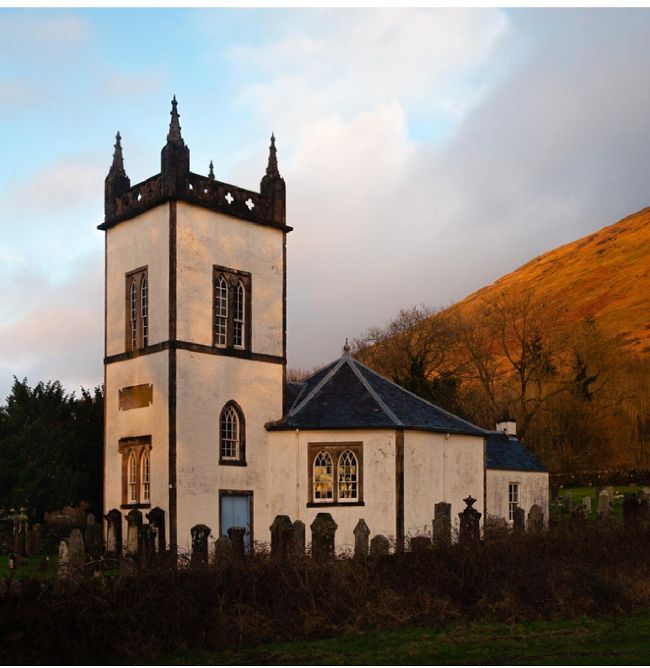
Kilmorich Parish Church Loch Fyne Cairndow Argyll & Bute ©subtlesensor
Ruthwell Cross
The Ruthwell Cross is a treasure hidden in plain sight. To access the church, the visitor has to collect a key from the nearby manse. Inside, this extraordinary 8th Century monument serves as a reminder of the Anglo-Saxon presence in southern Scotland, and a fascinating era in the influence of Northumbria and Strathclyde ebbed and flowed into one another’s territory. It is also a remarkable document in its own right, preserving part of the ‘Dream of the Rood’, recounting the Passion, in Old English runes, from the perspective of the cross. When I visited, I had run from Carlisle that morning, en route to Dumfries, and passed through the pretty Solway village of Powfoot. This is a few minutes’ drive, or an easy cycle or jog, away, and has a hotel with a pleasant outside dining area.
The Ruthwell Cross would fit nicely into a tour of Dumfries and Galloway which, for those interested in early Christianity, should also include the extraordinary excavations at Whithorn and St Ninian’s Cave.
Egilsay
Reaching Egilsay requires some commitment, but it is hugely rewarding. With a little knowledge of the life of St Magnus, I found the site of his martyrdom (in 1115) intensely moving. The imagination finds itself populating land and sea with the key players in the fateful drama of his last day, from the ships on the horizon to Magnus’ outnumbered followers on the hushed pebble beach to the east of the island. It is a place to linger and to pray.
Orkney is a treasure trove of historical sites, from prehistory (such as Skara Brae, the Ring of Brodgar and the Tomb of the Eagles) to the Second World War (such as the Italian Chapel and Scapa Flow). St Magnus Cathedral in Kirkwall is also well worth a visit.
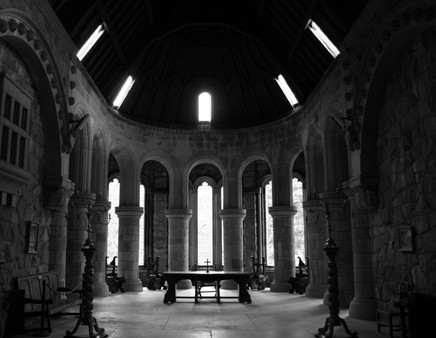
St Conan’s Kirk
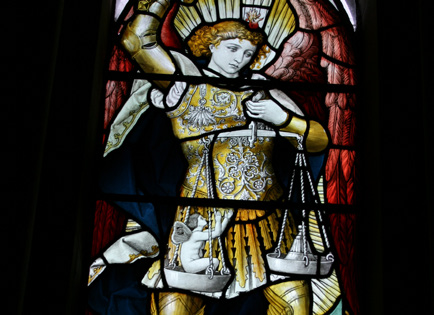
St Conan’s Kirk
St Blane’s Church, Bute
The ruin of St Blane’s Church is highly evocative of the 6th Century mission of Blane, an Irish contemporary of Columba and Moluag. The buildings themselves mostly date to a later foundation, with an equally intriguing history up until the Reformation, while a hogback tomb speaks also of the Norse presence on the island.
Half a century ago Bute was a popular tourist destination, and standing in the ruins of St Blane’s Church, looking over to Arran, Ayrshire, and the Kintyre Peninsula, it’s easy to see why. A ferry to Rothesay with a bike will set you up for an active weekend on this highly underrated island – perhaps earning some patisserie from the famous bakery set up by Syrian refugees.
* Embrace the Middle East supports Christian partners delivering healthcare, education and community development projects in Israel/Palestine, Syria, Egypt, Iraq and Lebanon. For more information visit https://embraceme.org
The Very Rev Ian Bradley, author of ‘Pilgrimage: A Spiritual and Cultural Journey’
St Conan’s Kirk, Dalmally, Argyll
Standing just off the main A85 road to Oban between Dalmally and Tyndrum, perched somewhat precariously on the north bank of Loch Awe, St Conan’s Kirk is arguably the most quirky, atmospheric and intriguing ecclesiastical building in Scotland.
It was built by Walter Campbell, an eccentric architect, in response to his mother’s complaints that the drive from their mansion house on an island in Loch Awe to the nearest parish church at Dalmally was too much for her. He initially built a relatively simple church in 1888 but later extended it into a much grander and more elaborate structure which was not finished until 1930. Built out of local Cruachan granite boulders, which were rolled down from the hill above, it is a hotchpotch of different architectural styles, Saxon, Norman and Romanesque, complete with cloisters, a vast chancel and semi-circular apse and an armour-clad effigy of Robert the Bruce. Well worth a visit if you are en route to Oban and the inner isles.
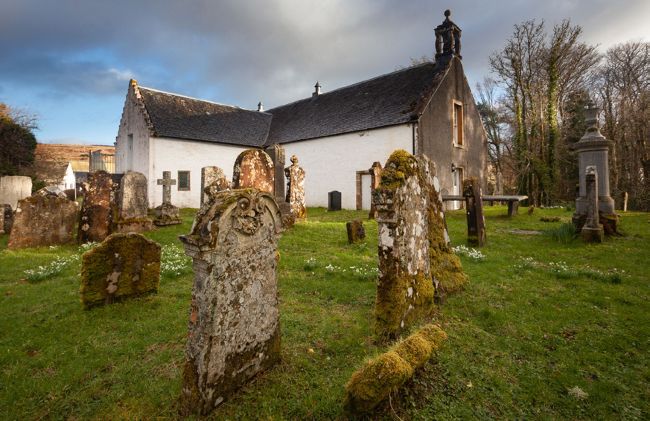
Kilfinan Chapel
St Fergus Well, Glamis, Angus
Walk through a little gate off the road that leads from Glamis Parish Church to the nearby castle and descend the steep steps to the fast flowing stream below. at the bottom of the steps on the left is St Fergus’ well shrouded in ferns and other vegetation. A metal cup chained to the rocks at the side allows you to take a scoop of water. St Fergus, the 7th or 8th century Irish missionary who supposedly evangelised this part of eastern Scotland, is said to have lived in a cave near the well and to have baptised converts to Christianity in it. For many years the well and its surrounds were neglected and accessible But in the early 1980s the then parish minister, Andrew Greaves, spearheaded a project in which unemployed local young people cleared the area and built a circular trail from the church that takes in the well and provides a minipilgrimage. It has a deeply spiritual atmosphere.
The Rev Alec Shuttleworth, minister at Saline and Blairingone linked with Tulliallan and Kincardine
Dumfriesshire
If you do not know the area it is worth pointing out what Dumfriesshire is not. It is not the Borders! It is not Galloway either.
We claim our share of notable historical figures. William Paterson, who having practically bankrupted Scotland in the Darien scheme was a founder of the Bank of England. Thomas Telford, the engineer and architect, (his church buildings are scattered around the highlands), and road and bridge builder. Taking advantage of these fine roads, Kirkpatrick Macmillan invented the bicycle, and among others who got on their bike and left Dumfriesshire behind is the current Moderator, Jim Wallace: Lord Wallace of Tankerness. And me.
“ Best of all, these sites are linked by a network of off-road pilgrim trails that will carry you through the landscape in much the same peace and solitude enjoyed by original Christians as they spread their message.”
Biking, walking or motoring are all good ways of rootling about Dumfriesshire. Walks up the Annan Valley, or along the roads that take you along the Solway Moss from Annan to Dumfriesshire. And on that route you will uncover plenty to interest you and intrigue.
Ruthwell village has the original savings bank, although there are moves to close the museum. It was the brainchild of a great local minister, Henry Duncan, who amongst other things was the Moderator of the Presbytery that tried Edward Irving for heresy. Edward Irving, the founder of the Catholic Apostolic Church and contemporary of another Annan Academy boy, Thomas Carlyle, has his statue in the grounds of Annan Old Kirk where his trial was held.
Get your map out, pack your picnic, buy a guidebook and breathe in the peace of this somewhat forgotten part of Scotland.
Professor John R Hume, architectural historian
Bourtie
Bourtie in Aberdeenshire was the subject of one of my first articles for Life and Work. Its little Georgian church is set in its graveyard in a hollow amid rolling farmland. The granite church, built in 1807 by James Walker, mason and William Sangster, wright, is rectangular, with a ‘piended’ roof. It has a little belfry, relic of an earlier church (1728) constructed on what has obviously been an ancient site. Built into the south wall of the building is part of a Pictish stone, strongly suggesting that there was at least a Christian burial ground here dating from the time of the mission led by St Columba from Iona to bring the good news of the Gospel to the people of Northern Pictland, some 1500 years ago.
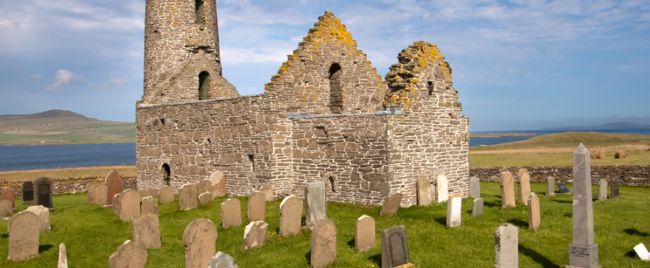
St Magnus Church, Island of Egilsay, Orkney
Inside on the north side is a gallery, facing the pulpit, with a canopied sounding-board, on the south wall, flanked by tall pointed windows. There is also a carved panel from a pew, dated 1669. In the foyer are medieval sculptures of a knight and his lady, moved from the churchyard in 1955. On a hill above the church are the remains of a stone circle, evidence of the pre-Christian sanctity of the area. These features alone would make a visit to Bourtie eminently worthwhile. What makes the place truly memorable, however, is the deep peace which one experiences there – truly a place to which to make a pilgrimage.
Symington
My other choice is in a very different setting, on a mounded churchyard in the middle of a central Ayrshire village. If you had seen Symington Parish Church in the late 19th or early 20th century you would have taken it for a typical village church of, probably, the 18th century (it was repaired and enlarged, by the construction of a north aisle in 1797). On closer examination you might have noticed the regular masonry blocks characteristic of 12th century work in the walls of the main body of the church and looked more carefully at the belfry, and perhaps seen its resemblance to 17th century belfries in rural Aberdeenshire.
The true significance of the building was not, however, revealed until 1919, when in the course of remodelling its interior the celebrated church architect Peter Macgregor Chalmers removed the plaster from the walls to reveal Romanesque (rounded) windows dating from the 12th century.
When at that time King David I had lowland Scotland divided into counties and parishes, he allocated parishes to his noble friends in which they were required to build stone churches. He gave the parish of Symington to Walter Fitzalan, a noble of Breton origin who he had brought up from Shropshire, and who he made High Steward of Scotland. Fitzalan in turn delegated the management of the parish to Symon (or Simon) Loccard (or Lockhart), hence the name Symington. This is the only surviving church of this period to survive in use in the west of Scotland.
As well as its very significant 12th century fabric the church also has an important open timber roof dating from the 17th century, and a fine suite of stained-glass windows by Douglas Strachan and Gordon Webster, two of the finest early 20thcentury stained-glass artists. Altogether this is a church well worth visiting, in one of Ayrshire’s most attractive villages.
*A Life of Industry: The Photography of John R Hume is published by Historic Environment Scotland on August 5